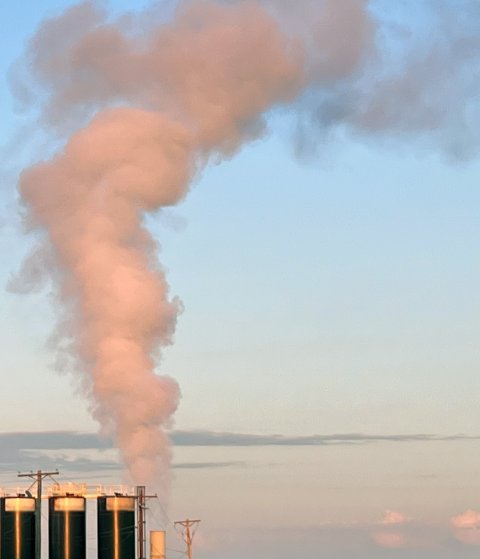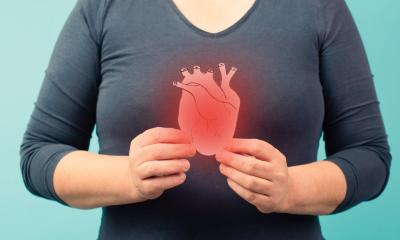© American Heart Association 2023
News • Adverse outdoor conditions
Heat waves and PM2.5 air pollution double risk of fatal heart attack
The combination of soaring heat and smothering fine particulate pollution may double the risk of heart attack death, according to a new study of more than 202,000 heart attack deaths in China.

Image source: AHA; © Yuewei Liu
“Extreme temperature events are becoming more frequent, longer and more intense, and their adverse health effects have drawn growing concern. Another environmental issue worldwide is the presence of fine particulate matter in the air, which may interact synergistically with extreme temperatures to adversely affect cardiovascular health,” said senior author Yuewei Liu, M.D., Ph.D., an associate professor of epidemiology in the School of Public Health at Sun Yat-sen University in Guangzhou, China. “However, it remains unknown if and how co-exposure to extreme temperatures and fine particulate pollution might interact to trigger a greater risk of death from heart attack, which is an acute response potentially brought on by an acute scenario and a great public health challenge due to its substantial disease burden worldwide.”
To examine the impact of extreme temperatures with and without high levels of fine particulate pollution, the researchers analyzed 202,678 heart attack deaths between 2015-2020 that occurred in Jiangsu province, a region with four distinct seasons and a wide range of temperatures and fine particulate pollution levels. The deaths were among older adults with an average age of 77.6 years; 52% were older than age 80; and 52% were male. Particulate exposure on the day of each death and one day before death were included in the analysis.

© American Heart Association
Extreme temperatures were gauged according to the daily heat index (also referred to as apparent temperature) for an area, which captures the combined effect of both heat and humidity. Both the length and extremeness of heat waves and cold snaps were evaluated. Heart attack deaths, or case days, during these periods were compared with control days on the same day of the week in the same month — meaning that if a death occurred on a Wednesday, all other Wednesdays in the same month would be considered control days. Particulate levels were considered high on any day with an average level of fine particulate matter above 37.5 micrograms per cubic meter. “Our findings provide evidence that reducing exposure to both extreme temperatures and fine particulate pollution may be useful to prevent premature deaths from heart attack, especially for women and older adults,” Liu said.
Compared with control days, the risk of a fatal heart attack was observed at the following levels:
- 18% higher during 2-day heat waves with heat indexes at or above the 90th percentile (ranging from 28,1 to 36,6°C / 82.6 to 97.9°F), increasing with temperature and duration, and was 74% higher during 4-day heat waves with heat indexes at or above the 97.5th percentile (ranging from 34,9 to 43°C / 94.8 to 109.4°F). For context, 6,417 (3.2%) of the 202,678 observed deaths from heart attack happened during heat waves with heat indexes at or above the 95th percentile (ranging from 32,9 to 40,4°C / 91.2 to 104.7°F) for three or more days.
- 4% higher during 2-day cold snaps with temperatures at or below the 10th percentile (ranging from 0,7 to 4,7°C / 33.3 to 40.5°F), increasing with lower temperatures and duration, and was 12% higher during 3-day cold snaps with temperatures at or below the 2.5th percentile (ranging from -2,8 to 2,9°C / 27.0 to 37.2°F). For context, 6,331 (3.1%) of the 202,678 observed deaths from heart attack happened during cold spells with temperatures at or below the 5th percentile (ranging from -1,1 to 3,6°C / 30.0 to 38.5°F) for 3 or more days.
- Twice as high during 4-day heat waves that had fine particulate pollution above 37.5 micrograms per cubic meter. Days with high levels of fine particulate pollution during cold snaps did not have an equivalent increase in the risk of heart attack death.
- Generally higher among women than men during heat waves.
- Higher among people ages 80 and older than in younger adults during heat waves, cold snaps or days with high levels of fine particulate pollution.
- The mean age of all individuals who died from a heart attack in Jiangsu from 2015-2020, including during non-extreme temperature events, was 77.6 years old; 52.1% of these individuals were over 80 years old.
The researchers estimated that up to 2.8% of heart attack deaths may be attributed to the combination of extreme temperatures and high levels of fine particulate pollution (> 37.5 micrograms per cubic meter), according to WHO targets.
“Strategies for individuals to avoid negative health effects from extreme temperatures include following weather forecasts, staying inside when temperatures are extreme, using fans and air conditioners during hot weather, dressing appropriately for the weather, proper hydration and installing window blinds to reduce indoor temperatures,” said Liu. “Using an air purifier in the house, wearing a mask outdoors, staying clear of busy highways when walking and choosing less-strenuous outdoor activities may also help to reduce exposure to air pollution on days with high levels of fine particulate pollution. To improve public health, it is important to take fine particulate pollution into consideration when providing extreme temperature warnings to the public.”
In a 2020 scientific statement and a 2020 policy statement, the American Heart Association details the latest science about air pollution exposure and the individual, industrial and policy measures to reduce the negative impact of poor air quality on cardiovascular health. Reducing exposure to air pollution and reversing the negative impact of poor air quality on cardiovascular health, including heart disease and stroke, is essential to reducing health inequities in Black and Hispanic communities, those that have been historically marginalized and under-resourced, and communities that have the highest levels of exposure to air pollution.
The investigators recommended additional research about the possible interactive effects of extreme weather events and fine particulate pollution on heart attack deaths in areas with different temperature and pollution ranges to confirm their findings. The study did not include adjustments for any adaptive behaviors taken by individuals, such as using air conditioning and staying indoors, when temperatures are extreme or pollution levels are high, which could cause misclassification of individuals’ exposure to weather and alter their risk patterns. These results also may not be generalizable to other regions in China or other countries due to potential variations of adaption capacity and temperature distribution.
Source: American Heart Association
25.07.2023











